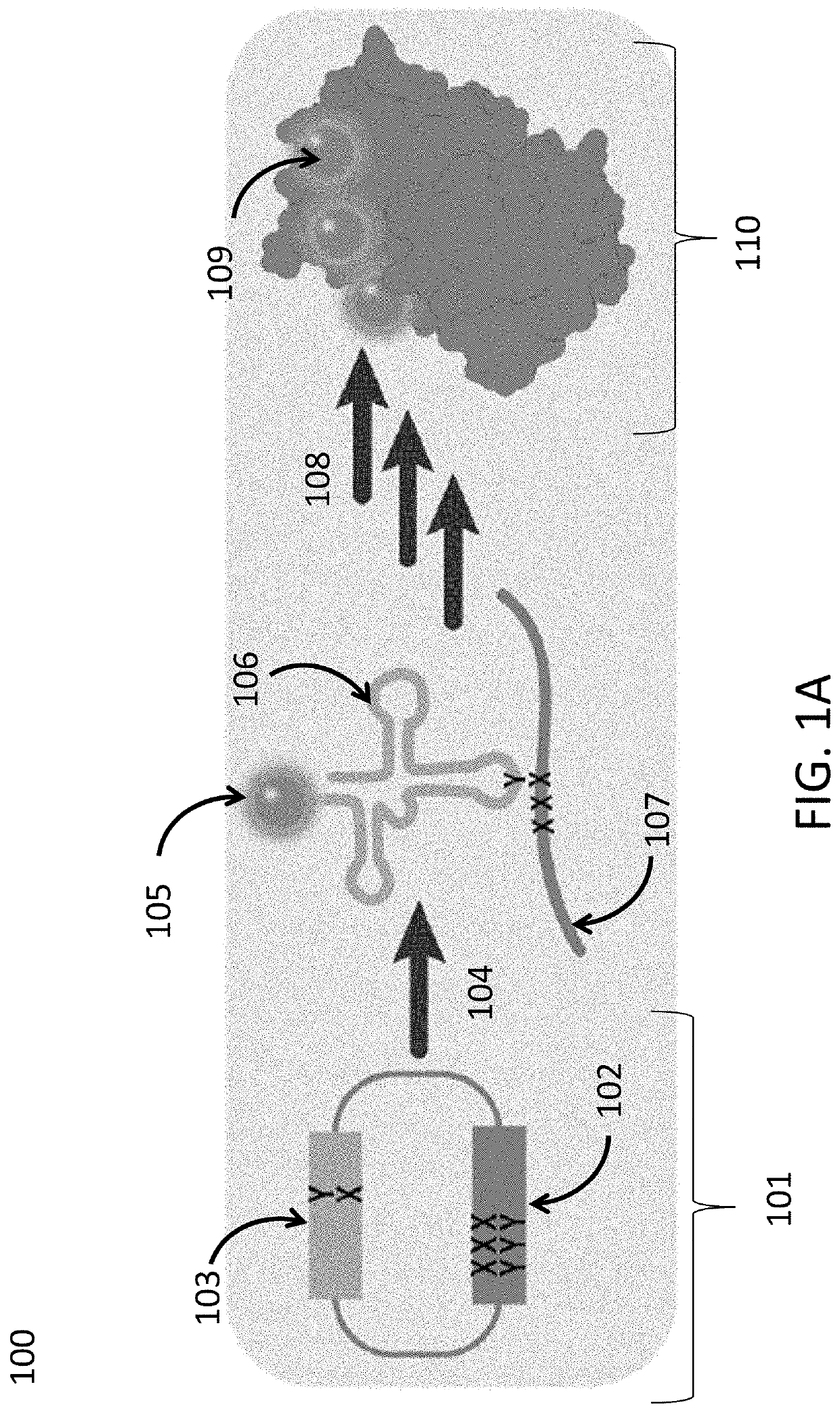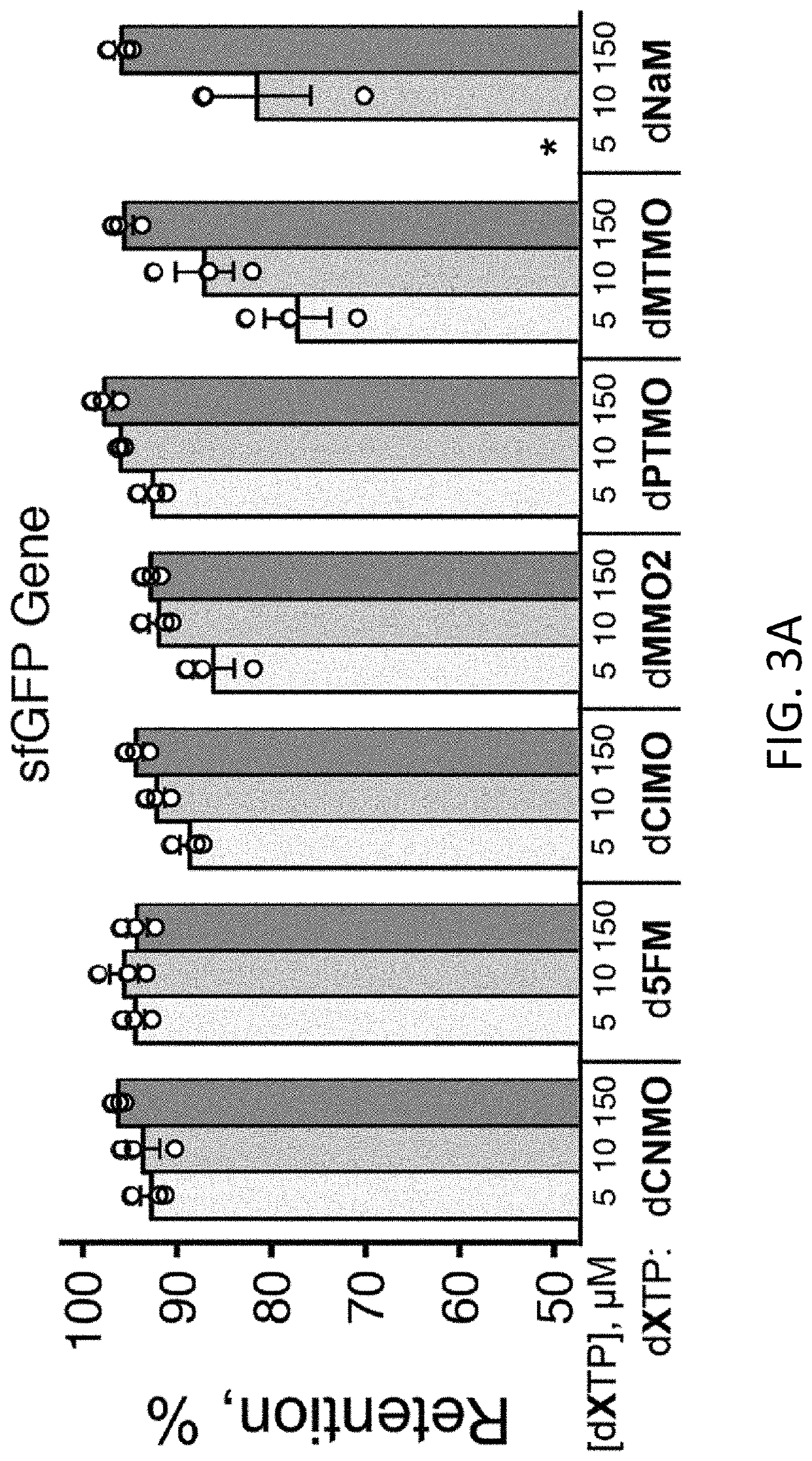Reagents and methods for replication, transcription, and translation in semi-synthetic organisms
a technology of semi-synthetic organisms and reagents, applied in the field of semi-synthetic organisms, can solve the problems of limiting what might actually be explored, limiting the physiochemical diversity of natural amino acids, and simply not being able to function, so as to achieve the effect of increasing production
- Summary
- Abstract
- Description
- Claims
- Application Information
AI Technical Summary
Benefits of technology
Problems solved by technology
Method used
Image
Examples
example 1a
f Replication and Templating of Transcription
[0721]Plasmids were constructed with two dNaM-dTPT3 UBPs, such that the sequence AXC (here and throughout X refers to (d)NaM or a (d)NaM analog) was positioned to template codon 151 of sfGFP mRNA (sfGFP151(AXC)) and with the sequence GYT (here and throughout Y refers to (d)TPT3 or a (d)TPT3 analog) positioned to template the anticodon of the M. mazei Pyl tRNA (tRNAPyl(GYT)), which is selectively charged with the ncAA N6-(2-azidoethoxy)-carbonyl-L-lysine (AzK) by the M. barkeri pyrrolysyl-tRNA synthetase (Mb PylRS). These plasmids were used to transform E. coli expressing the nucleoside triphosphate transporter PtNTT2 (strain YZ38) and harboring a plasmid encoding Mb PylRS. After transformation, colonies were selected and grown to an OD600˜1.0 in liquid media supplemented with dTPT3TP (10 μM) and one of seven different dXTPs (FIG. 2) added at varying concentrations (150 μM, 10 μM, or 5 μM). Cells were then diluted into fresh expression med...
example 1b
rocedures for Replication and Templating of Transcription
[0726]Golden Gate assembly of plasmids. Inserts containing the UBP (and if necessary, genes encoding sfGFP or tRNAPyl) were generated by PCR of unnatural-containing oligonucleotides O3 and O6-12 (see Table S4 for oligo sequences) either synthesized manually (see Oligonucleotide Synthesis) or gifted from Synthorx, using dTPT3TP and dNaMTP, and primers P1-2 (when amplifying O3 or O7-12) and P3-4 (when amplifying O6) (see Table S for primer sequences) to create terminal BsaI recognition sites that, once digested, introduce overhangs compatible with the appropriate destination plasmid p[sfGFP(gg)151 tRNAPyl(gg)] GG destination plasmid for sfGFP translation, sequence as shown below (SEQ ID NO: 2). PCR amplifications were performed in a PTC-200 Peltier Thermal Cycler (MJ Research). Template oligonucleotides (0.025 ng per 50 μL reaction) were PCR-amplified using the following reagent concentrations: OneTaq Standard Reaction Buffer (1...
example 2
and First SAR Analysis of Ribonucleotide Candidates
[0743]Retrieval of the information made available by the UBP has only previously been explored using NaMTP and TPT3TP. To begin to elucidate the SARs governing efficient transcription and translation in the SSO, nine novel NaMTP analogs (FIG. 4A) and four novel TPT3TP analogs (FIG. 4B) were designed and synthesized. These analogs were designed to explore the role of nucleobase shape, aromatic surface area, and heteroatom derivatization. Generally, the synthesis of the XTP analogs proceeded via lithiation of the corresponding aryl halide, followed by coupling of the lithiated species to either the benzyl- or TBS-protected ribolactone. Reduction of the resulting hemi-acetal intermediate in the presence of boron trifluoride diethyl etherate and triethylsilane afforded the desired protected nucleoside in each case. Following deprotection, the resulting X nucleoside analogs were converted to triphosphates using standard Ludwig phosphoryl...
PUM
| Property | Measurement | Unit |
|---|---|---|
| Fraction | aaaaa | aaaaa |
| Fraction | aaaaa | aaaaa |
| Fraction | aaaaa | aaaaa |
Abstract
Description
Claims
Application Information
 Login to View More
Login to View More - R&D
- Intellectual Property
- Life Sciences
- Materials
- Tech Scout
- Unparalleled Data Quality
- Higher Quality Content
- 60% Fewer Hallucinations
Browse by: Latest US Patents, China's latest patents, Technical Efficacy Thesaurus, Application Domain, Technology Topic, Popular Technical Reports.
© 2025 PatSnap. All rights reserved.Legal|Privacy policy|Modern Slavery Act Transparency Statement|Sitemap|About US| Contact US: help@patsnap.com



